[English] 日本語
 Yorodumi
Yorodumi- PDB-4yne: (R)-2-Phenylpyrrolidine Substitute Imidazopyridazines: a New Clas... -
+ Open data
Open data
- Basic information
Basic information
| Entry | Database: PDB / ID: 4yne | ||||||
|---|---|---|---|---|---|---|---|
| Title | (R)-2-Phenylpyrrolidine Substitute Imidazopyridazines: a New Class of Potent and Selective Pan-TRK Inhibitors | ||||||
 Components Components | High affinity nerve growth factor receptor | ||||||
 Keywords Keywords | Transferase/Transferase inhibitor / Kinase / TRK / Inhibitor / Oncology / Transferase-Transferase inhibitor complex | ||||||
| Function / homology |  Function and homology information Function and homology informationneurotrophin p75 receptor binding / behavioral response to formalin induced pain / olfactory nerve development / TRKA activation by NGF / PLC-gamma1 signalling / Signalling to STAT3 / programmed cell death involved in cell development / response to hydrostatic pressure / neurotrophin receptor activity / mechanoreceptor differentiation ...neurotrophin p75 receptor binding / behavioral response to formalin induced pain / olfactory nerve development / TRKA activation by NGF / PLC-gamma1 signalling / Signalling to STAT3 / programmed cell death involved in cell development / response to hydrostatic pressure / neurotrophin receptor activity / mechanoreceptor differentiation / nerve growth factor receptor activity / neurotrophin binding / GPI-linked ephrin receptor activity / axonogenesis involved in innervation / nerve growth factor signaling pathway / Sertoli cell development / Retrograde neurotrophin signalling / nerve growth factor binding / sympathetic nervous system development / NGF-independant TRKA activation / Signalling to p38 via RIT and RIN / ARMS-mediated activation / positive regulation of Ras protein signal transduction / positive regulation of programmed cell death / positive regulation of synapse assembly / PI3K/AKT activation / peptidyl-tyrosine autophosphorylation / Frs2-mediated activation / neurotrophin TRK receptor signaling pathway / detection of temperature stimulus involved in sensory perception of pain / response to electrical stimulus / positive regulation of GTPase activity / Signalling to RAS / detection of mechanical stimulus involved in sensory perception of pain / neuron development / positive regulation of synaptic transmission, glutamatergic / response to axon injury / transmembrane receptor protein tyrosine kinase activity / axon guidance / cell surface receptor protein tyrosine kinase signaling pathway / peptidyl-tyrosine phosphorylation / B cell differentiation / response to nutrient levels / positive regulation of neuron projection development / receptor protein-tyrosine kinase / cellular response to nerve growth factor stimulus / circadian rhythm / : / cellular response to nicotine / kinase binding / recycling endosome membrane / neuron projection development / positive regulation of angiogenesis / late endosome membrane / late endosome / protein autophosphorylation / protein tyrosine kinase activity / neuron apoptotic process / early endosome membrane / spermatogenesis / negative regulation of neuron apoptotic process / learning or memory / early endosome / protein phosphorylation / positive regulation of ERK1 and ERK2 cascade / positive regulation of phosphatidylinositol 3-kinase/protein kinase B signal transduction / receptor complex / endosome membrane / response to xenobiotic stimulus / axon / negative regulation of cell population proliferation / neuronal cell body / dendrite / negative regulation of apoptotic process / cell surface / protein homodimerization activity / protein-containing complex / mitochondrion / ATP binding / identical protein binding / plasma membrane Similarity search - Function | ||||||
| Biological species |  Homo sapiens (human) Homo sapiens (human) | ||||||
| Method |  X-RAY DIFFRACTION / X-RAY DIFFRACTION /  SYNCHROTRON / SYNCHROTRON /  MOLECULAR REPLACEMENT / Resolution: 2.0229 Å MOLECULAR REPLACEMENT / Resolution: 2.0229 Å | ||||||
 Authors Authors | Kreusch, A. / Rucker, P. / Molteni, V. / Loren, J. | ||||||
 Citation Citation |  Journal: Acs Med.Chem.Lett. / Year: 2015 Journal: Acs Med.Chem.Lett. / Year: 2015Title: (R)-2-Phenylpyrrolidine Substituted Imidazopyridazines: A New Class of Potent and Selective Pan-TRK Inhibitors. Authors: Choi, H.S. / Rucker, P.V. / Wang, Z. / Fan, Y. / Albaugh, P. / Chopiuk, G. / Gessier, F. / Sun, F. / Adrian, F. / Liu, G. / Hood, T. / Li, N. / Jia, Y. / Che, J. / McCormack, S. / Li, A. / ...Authors: Choi, H.S. / Rucker, P.V. / Wang, Z. / Fan, Y. / Albaugh, P. / Chopiuk, G. / Gessier, F. / Sun, F. / Adrian, F. / Liu, G. / Hood, T. / Li, N. / Jia, Y. / Che, J. / McCormack, S. / Li, A. / Li, J. / Steffy, A. / Culazzo, A. / Tompkins, C. / Phung, V. / Kreusch, A. / Lu, M. / Hu, B. / Chaudhary, A. / Prashad, M. / Tuntland, T. / Liu, B. / Harris, J. / Seidel, H.M. / Loren, J. / Molteni, V. | ||||||
| History |
|
- Structure visualization
Structure visualization
| Structure viewer | Molecule:  Molmil Molmil Jmol/JSmol Jmol/JSmol |
|---|
- Downloads & links
Downloads & links
- Download
Download
| PDBx/mmCIF format |  4yne.cif.gz 4yne.cif.gz | 135.9 KB | Display |  PDBx/mmCIF format PDBx/mmCIF format |
|---|---|---|---|---|
| PDB format |  pdb4yne.ent.gz pdb4yne.ent.gz | 104.7 KB | Display |  PDB format PDB format |
| PDBx/mmJSON format |  4yne.json.gz 4yne.json.gz | Tree view |  PDBx/mmJSON format PDBx/mmJSON format | |
| Others |  Other downloads Other downloads |
-Validation report
| Summary document |  4yne_validation.pdf.gz 4yne_validation.pdf.gz | 870.9 KB | Display |  wwPDB validaton report wwPDB validaton report |
|---|---|---|---|---|
| Full document |  4yne_full_validation.pdf.gz 4yne_full_validation.pdf.gz | 873.6 KB | Display | |
| Data in XML |  4yne_validation.xml.gz 4yne_validation.xml.gz | 13.6 KB | Display | |
| Data in CIF |  4yne_validation.cif.gz 4yne_validation.cif.gz | 18.4 KB | Display | |
| Arichive directory |  https://data.pdbj.org/pub/pdb/validation_reports/yn/4yne https://data.pdbj.org/pub/pdb/validation_reports/yn/4yne ftp://data.pdbj.org/pub/pdb/validation_reports/yn/4yne ftp://data.pdbj.org/pub/pdb/validation_reports/yn/4yne | HTTPS FTP |
-Related structure data
| Related structure data | 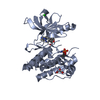 4ymjC  4ypsC 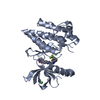 3v5qS S: Starting model for refinement C: citing same article ( |
|---|---|
| Similar structure data |
- Links
Links
- Assembly
Assembly
| Deposited unit | 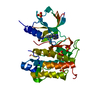
| ||||||||
|---|---|---|---|---|---|---|---|---|---|
| 1 |
| ||||||||
| Unit cell |
|
- Components
Components
| #1: Protein | Mass: 34261.613 Da / Num. of mol.: 1 Source method: isolated from a genetically manipulated source Source: (gene. exp.)  Homo sapiens (human) / Gene: NTRK1, MTC, TRK, TRKA / Plasmid: pFastBac1-HM / Cell line (production host): SF9 / Production host: Homo sapiens (human) / Gene: NTRK1, MTC, TRK, TRKA / Plasmid: pFastBac1-HM / Cell line (production host): SF9 / Production host:  References: UniProt: P04629, receptor protein-tyrosine kinase | ||||
|---|---|---|---|---|---|
| #2: Chemical | ChemComp-4EK / | ||||
| #3: Chemical | ChemComp-SO4 / #4: Chemical | ChemComp-GOL / | #5: Water | ChemComp-HOH / | |
-Experimental details
-Experiment
| Experiment | Method:  X-RAY DIFFRACTION / Number of used crystals: 1 X-RAY DIFFRACTION / Number of used crystals: 1 |
|---|
- Sample preparation
Sample preparation
| Crystal | Density Matthews: 3.23 Å3/Da / Density % sol: 62 % |
|---|---|
| Crystal grow | Temperature: 277 K / Method: vapor diffusion, sitting drop / pH: 5 / Details: 0.8M (NH4)2SO4, 0.1M Citrate pH 5.0 |
-Data collection
| Diffraction | Mean temperature: 100 K |
|---|---|
| Diffraction source | Source:  SYNCHROTRON / Site: SYNCHROTRON / Site:  ALS ALS  / Beamline: 5.0.3 / Wavelength: 0.9765 Å / Beamline: 5.0.3 / Wavelength: 0.9765 Å |
| Detector | Type: ADSC QUANTUM 315r / Detector: CCD / Date: Apr 28, 2012 |
| Radiation | Protocol: SINGLE WAVELENGTH / Monochromatic (M) / Laue (L): M / Scattering type: x-ray |
| Radiation wavelength | Wavelength: 0.9765 Å / Relative weight: 1 |
| Reflection | Resolution: 2.02→34.13 Å / Num. obs: 29032 / % possible obs: 99.81 % / Redundancy: 5.6 % / Biso Wilson estimate: 45.64 Å2 / Rmerge(I) obs: 0.035 / Net I/σ(I): 12.3 |
| Reflection shell | Resolution: 2.02→2.05 Å / Redundancy: 5.1 % / Rmerge(I) obs: 0.575 / % possible all: 100 |
- Processing
Processing
| Software |
| ||||||||||||||||||||||||||||||||||||||||||||||||||||||||||||||||||||||||||||||||||||
|---|---|---|---|---|---|---|---|---|---|---|---|---|---|---|---|---|---|---|---|---|---|---|---|---|---|---|---|---|---|---|---|---|---|---|---|---|---|---|---|---|---|---|---|---|---|---|---|---|---|---|---|---|---|---|---|---|---|---|---|---|---|---|---|---|---|---|---|---|---|---|---|---|---|---|---|---|---|---|---|---|---|---|---|---|---|
| Refinement | Method to determine structure:  MOLECULAR REPLACEMENT MOLECULAR REPLACEMENTStarting model: 3V5Q Resolution: 2.0229→34.129 Å / SU ML: 0.2 / Cross valid method: FREE R-VALUE / σ(F): 1.35 / Phase error: 23.15 / Stereochemistry target values: ML
| ||||||||||||||||||||||||||||||||||||||||||||||||||||||||||||||||||||||||||||||||||||
| Solvent computation | Shrinkage radii: 0.9 Å / VDW probe radii: 1.11 Å / Solvent model: FLAT BULK SOLVENT MODEL | ||||||||||||||||||||||||||||||||||||||||||||||||||||||||||||||||||||||||||||||||||||
| Displacement parameters | Biso mean: 56.66 Å2 | ||||||||||||||||||||||||||||||||||||||||||||||||||||||||||||||||||||||||||||||||||||
| Refinement step | Cycle: LAST / Resolution: 2.0229→34.129 Å
| ||||||||||||||||||||||||||||||||||||||||||||||||||||||||||||||||||||||||||||||||||||
| Refine LS restraints |
| ||||||||||||||||||||||||||||||||||||||||||||||||||||||||||||||||||||||||||||||||||||
| LS refinement shell |
| ||||||||||||||||||||||||||||||||||||||||||||||||||||||||||||||||||||||||||||||||||||
| Refinement TLS params. | Method: refined / Origin x: -25.6387 Å / Origin y: -42.9463 Å / Origin z: -19.4055 Å
| ||||||||||||||||||||||||||||||||||||||||||||||||||||||||||||||||||||||||||||||||||||
| Refinement TLS group | Selection details: all |
 Movie
Movie Controller
Controller


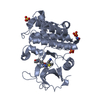
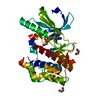
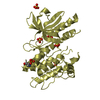
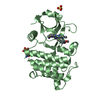
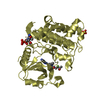
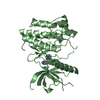
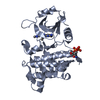

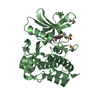
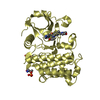
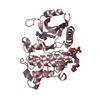
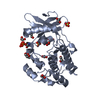
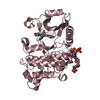
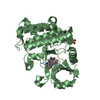

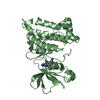
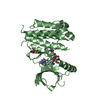
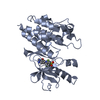
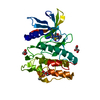
 PDBj
PDBj
















